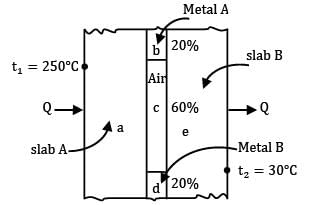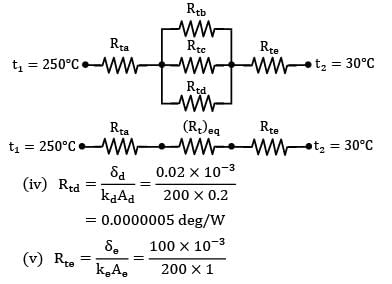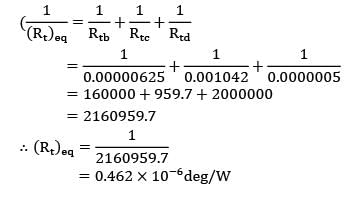Chemical Engineering Exam > Chemical Engineering Questions > Two slabs, each 100 mm thick and made of mat...
Start Learning for Free
Two slabs, each 100 mm thick and made of materials with thermal conductivities of 16 W/m-deg and 1600 W/m-°C, are placed in contact which is not perfect. Due to roughness of surfaces, only 40% of the area is in contact and air fills 0.02 mm thick gaps in the remaining area. If the extreme surfaces of the arrangement are at temperatures of 250°C and 30°C, determine the heat flow rate through the composite system.
Take thermal conductivity of air as 0.032 W/m-°C and assume that half of the contact (of the contact area) is due to either metal.
- a)32
- b)33
Correct answer is between '32,33'. Can you explain this answer?
| FREE This question is part of | Download PDF Attempt this Test |
Verified Answer
Two slabs, each 100 mm thick and made of materials with thermal condu...
Refer figure for the composite system and it’s equivalent thermal resistance The various thermal resistances to flow of heat are





View all questions of this test

= 0.00000625 deg/W


= 0.0005 deg/W
The resistances Rtb, Rtc and Rtd are in a parallel connection and their equivalent resistance (Rt)eq is

This equivalent resistance is now in series with resistance Rta and Rte, the total thermal resistance for the entire circuit then becomes

= 0.00675 deg/W
Hence, heat transfer rate through the system is

Most Upvoted Answer
Two slabs, each 100 mm thick and made of materials with thermal condu...
Problem Statement: Two slabs with different thermal conductivities and imperfect contact are placed in between surfaces with different temperatures. The goal is to determine the heat flow rate through the composite system.
Solution:
Given parameters:
- Slab thickness (l) = 100 mm = 0.1 m
- Thermal conductivity of first slab (k1) = 16 W/m-°C
- Thermal conductivity of second slab (k2) = 1600 W/m-°C
- Total contact area (A) = 100%
- Actual contact area (Ac) = 40% of A = 0.4A
- Air gap thickness (x) = 0.02 mm = 0.00002 m
- Temperature difference (ΔT) = 250°C - 30°C = 220°C
- Thermal conductivity of air (ka) = 0.032 W/m-°C
- Half of the contact area is due to either metal.
Assumptions:
- Steady-state heat transfer
- One-dimensional heat transfer
- Uniform temperature distribution along the cross-section of each slab
Calculation:
Step 1: Determine the effective thermal conductivity of the composite system.
- Resistance of the first slab = l/k1A
- Resistance of the second slab = l/k2A
- Resistance of the air gap = x/kaAc
- Total resistance = Resistance of the first slab + Resistance of the second slab + Resistance of the air gap
- Effective thermal conductivity = l/(Total resistance x A)
Resistance of the first slab = 0.1/(16 x 1) = 0.00625°C/W
Resistance of the second slab = 0.1/(1600 x 1) = 0.0000625°C/W
Resistance of the air gap = 0.00002/(0.032 x 0.4A) = 0.001302°C/W
Total resistance = 0.00625 + 0.0000625 + 0.001302 = 0.0076155°C/W
Effective thermal conductivity = 0.1/(0.0076155 x 1) = 13.129 W/m-°C
Step 2: Determine the heat flow rate through the composite system.
- Heat flow rate (Q) = Effective thermal conductivity x A x ΔT
Heat flow rate (Q) = 13.129 x 1 x 220 = 2880.38 W
Answer: The heat flow rate through the composite system is 2880.38 W (rounded off to two decimal places). Therefore, the correct answer is 32-33 (since it falls between these two values).
Solution:
Given parameters:
- Slab thickness (l) = 100 mm = 0.1 m
- Thermal conductivity of first slab (k1) = 16 W/m-°C
- Thermal conductivity of second slab (k2) = 1600 W/m-°C
- Total contact area (A) = 100%
- Actual contact area (Ac) = 40% of A = 0.4A
- Air gap thickness (x) = 0.02 mm = 0.00002 m
- Temperature difference (ΔT) = 250°C - 30°C = 220°C
- Thermal conductivity of air (ka) = 0.032 W/m-°C
- Half of the contact area is due to either metal.
Assumptions:
- Steady-state heat transfer
- One-dimensional heat transfer
- Uniform temperature distribution along the cross-section of each slab
Calculation:
Step 1: Determine the effective thermal conductivity of the composite system.
- Resistance of the first slab = l/k1A
- Resistance of the second slab = l/k2A
- Resistance of the air gap = x/kaAc
- Total resistance = Resistance of the first slab + Resistance of the second slab + Resistance of the air gap
- Effective thermal conductivity = l/(Total resistance x A)
Resistance of the first slab = 0.1/(16 x 1) = 0.00625°C/W
Resistance of the second slab = 0.1/(1600 x 1) = 0.0000625°C/W
Resistance of the air gap = 0.00002/(0.032 x 0.4A) = 0.001302°C/W
Total resistance = 0.00625 + 0.0000625 + 0.001302 = 0.0076155°C/W
Effective thermal conductivity = 0.1/(0.0076155 x 1) = 13.129 W/m-°C
Step 2: Determine the heat flow rate through the composite system.
- Heat flow rate (Q) = Effective thermal conductivity x A x ΔT
Heat flow rate (Q) = 13.129 x 1 x 220 = 2880.38 W
Answer: The heat flow rate through the composite system is 2880.38 W (rounded off to two decimal places). Therefore, the correct answer is 32-33 (since it falls between these two values).

|
Explore Courses for Chemical Engineering exam
|

|
Similar Chemical Engineering Doubts
Two slabs, each 100 mm thick and made of materials with thermal conductivities of 16 W/m-deg and 1600 W/m-°C, are placed in contact which is not perfect. Due to roughness of surfaces, only 40% of the area is in contact and air fills 0.02 mm thick gaps in the remaining area. If the extreme surfaces of the arrangement are at temperatures of 250°C and 30°C, determine the heat flow rate through the composite system.Take thermal conductivity of air as 0.032 W/m-°C and assume that half of the contact (of the contact area) is due to either metal.a)32b)33Correct answer is between '32,33'. Can you explain this answer?
Question Description
Two slabs, each 100 mm thick and made of materials with thermal conductivities of 16 W/m-deg and 1600 W/m-°C, are placed in contact which is not perfect. Due to roughness of surfaces, only 40% of the area is in contact and air fills 0.02 mm thick gaps in the remaining area. If the extreme surfaces of the arrangement are at temperatures of 250°C and 30°C, determine the heat flow rate through the composite system.Take thermal conductivity of air as 0.032 W/m-°C and assume that half of the contact (of the contact area) is due to either metal.a)32b)33Correct answer is between '32,33'. Can you explain this answer? for Chemical Engineering 2024 is part of Chemical Engineering preparation. The Question and answers have been prepared according to the Chemical Engineering exam syllabus. Information about Two slabs, each 100 mm thick and made of materials with thermal conductivities of 16 W/m-deg and 1600 W/m-°C, are placed in contact which is not perfect. Due to roughness of surfaces, only 40% of the area is in contact and air fills 0.02 mm thick gaps in the remaining area. If the extreme surfaces of the arrangement are at temperatures of 250°C and 30°C, determine the heat flow rate through the composite system.Take thermal conductivity of air as 0.032 W/m-°C and assume that half of the contact (of the contact area) is due to either metal.a)32b)33Correct answer is between '32,33'. Can you explain this answer? covers all topics & solutions for Chemical Engineering 2024 Exam. Find important definitions, questions, meanings, examples, exercises and tests below for Two slabs, each 100 mm thick and made of materials with thermal conductivities of 16 W/m-deg and 1600 W/m-°C, are placed in contact which is not perfect. Due to roughness of surfaces, only 40% of the area is in contact and air fills 0.02 mm thick gaps in the remaining area. If the extreme surfaces of the arrangement are at temperatures of 250°C and 30°C, determine the heat flow rate through the composite system.Take thermal conductivity of air as 0.032 W/m-°C and assume that half of the contact (of the contact area) is due to either metal.a)32b)33Correct answer is between '32,33'. Can you explain this answer?.
Two slabs, each 100 mm thick and made of materials with thermal conductivities of 16 W/m-deg and 1600 W/m-°C, are placed in contact which is not perfect. Due to roughness of surfaces, only 40% of the area is in contact and air fills 0.02 mm thick gaps in the remaining area. If the extreme surfaces of the arrangement are at temperatures of 250°C and 30°C, determine the heat flow rate through the composite system.Take thermal conductivity of air as 0.032 W/m-°C and assume that half of the contact (of the contact area) is due to either metal.a)32b)33Correct answer is between '32,33'. Can you explain this answer? for Chemical Engineering 2024 is part of Chemical Engineering preparation. The Question and answers have been prepared according to the Chemical Engineering exam syllabus. Information about Two slabs, each 100 mm thick and made of materials with thermal conductivities of 16 W/m-deg and 1600 W/m-°C, are placed in contact which is not perfect. Due to roughness of surfaces, only 40% of the area is in contact and air fills 0.02 mm thick gaps in the remaining area. If the extreme surfaces of the arrangement are at temperatures of 250°C and 30°C, determine the heat flow rate through the composite system.Take thermal conductivity of air as 0.032 W/m-°C and assume that half of the contact (of the contact area) is due to either metal.a)32b)33Correct answer is between '32,33'. Can you explain this answer? covers all topics & solutions for Chemical Engineering 2024 Exam. Find important definitions, questions, meanings, examples, exercises and tests below for Two slabs, each 100 mm thick and made of materials with thermal conductivities of 16 W/m-deg and 1600 W/m-°C, are placed in contact which is not perfect. Due to roughness of surfaces, only 40% of the area is in contact and air fills 0.02 mm thick gaps in the remaining area. If the extreme surfaces of the arrangement are at temperatures of 250°C and 30°C, determine the heat flow rate through the composite system.Take thermal conductivity of air as 0.032 W/m-°C and assume that half of the contact (of the contact area) is due to either metal.a)32b)33Correct answer is between '32,33'. Can you explain this answer?.
Solutions for Two slabs, each 100 mm thick and made of materials with thermal conductivities of 16 W/m-deg and 1600 W/m-°C, are placed in contact which is not perfect. Due to roughness of surfaces, only 40% of the area is in contact and air fills 0.02 mm thick gaps in the remaining area. If the extreme surfaces of the arrangement are at temperatures of 250°C and 30°C, determine the heat flow rate through the composite system.Take thermal conductivity of air as 0.032 W/m-°C and assume that half of the contact (of the contact area) is due to either metal.a)32b)33Correct answer is between '32,33'. Can you explain this answer? in English & in Hindi are available as part of our courses for Chemical Engineering.
Download more important topics, notes, lectures and mock test series for Chemical Engineering Exam by signing up for free.
Here you can find the meaning of Two slabs, each 100 mm thick and made of materials with thermal conductivities of 16 W/m-deg and 1600 W/m-°C, are placed in contact which is not perfect. Due to roughness of surfaces, only 40% of the area is in contact and air fills 0.02 mm thick gaps in the remaining area. If the extreme surfaces of the arrangement are at temperatures of 250°C and 30°C, determine the heat flow rate through the composite system.Take thermal conductivity of air as 0.032 W/m-°C and assume that half of the contact (of the contact area) is due to either metal.a)32b)33Correct answer is between '32,33'. Can you explain this answer? defined & explained in the simplest way possible. Besides giving the explanation of
Two slabs, each 100 mm thick and made of materials with thermal conductivities of 16 W/m-deg and 1600 W/m-°C, are placed in contact which is not perfect. Due to roughness of surfaces, only 40% of the area is in contact and air fills 0.02 mm thick gaps in the remaining area. If the extreme surfaces of the arrangement are at temperatures of 250°C and 30°C, determine the heat flow rate through the composite system.Take thermal conductivity of air as 0.032 W/m-°C and assume that half of the contact (of the contact area) is due to either metal.a)32b)33Correct answer is between '32,33'. Can you explain this answer?, a detailed solution for Two slabs, each 100 mm thick and made of materials with thermal conductivities of 16 W/m-deg and 1600 W/m-°C, are placed in contact which is not perfect. Due to roughness of surfaces, only 40% of the area is in contact and air fills 0.02 mm thick gaps in the remaining area. If the extreme surfaces of the arrangement are at temperatures of 250°C and 30°C, determine the heat flow rate through the composite system.Take thermal conductivity of air as 0.032 W/m-°C and assume that half of the contact (of the contact area) is due to either metal.a)32b)33Correct answer is between '32,33'. Can you explain this answer? has been provided alongside types of Two slabs, each 100 mm thick and made of materials with thermal conductivities of 16 W/m-deg and 1600 W/m-°C, are placed in contact which is not perfect. Due to roughness of surfaces, only 40% of the area is in contact and air fills 0.02 mm thick gaps in the remaining area. If the extreme surfaces of the arrangement are at temperatures of 250°C and 30°C, determine the heat flow rate through the composite system.Take thermal conductivity of air as 0.032 W/m-°C and assume that half of the contact (of the contact area) is due to either metal.a)32b)33Correct answer is between '32,33'. Can you explain this answer? theory, EduRev gives you an
ample number of questions to practice Two slabs, each 100 mm thick and made of materials with thermal conductivities of 16 W/m-deg and 1600 W/m-°C, are placed in contact which is not perfect. Due to roughness of surfaces, only 40% of the area is in contact and air fills 0.02 mm thick gaps in the remaining area. If the extreme surfaces of the arrangement are at temperatures of 250°C and 30°C, determine the heat flow rate through the composite system.Take thermal conductivity of air as 0.032 W/m-°C and assume that half of the contact (of the contact area) is due to either metal.a)32b)33Correct answer is between '32,33'. Can you explain this answer? tests, examples and also practice Chemical Engineering tests.

|
Explore Courses for Chemical Engineering exam
|

|
Suggested Free Tests
Signup for Free!
Signup to see your scores go up within 7 days! Learn & Practice with 1000+ FREE Notes, Videos & Tests.


















